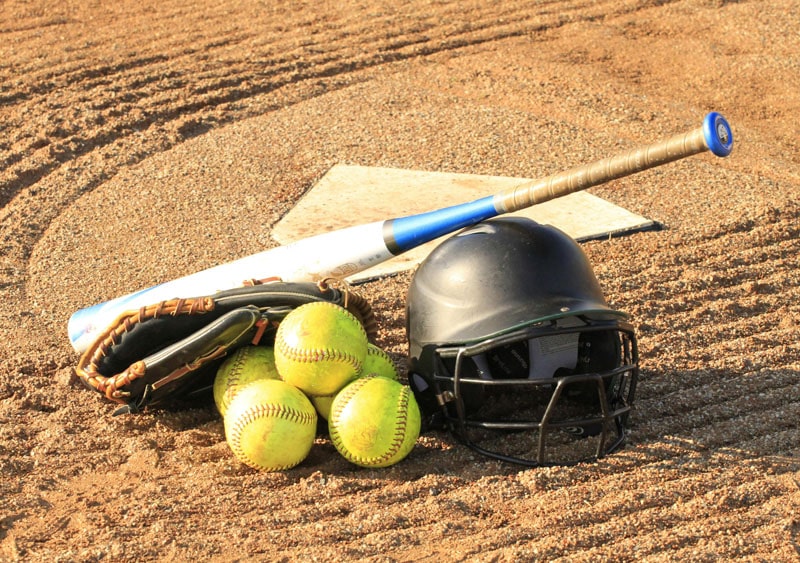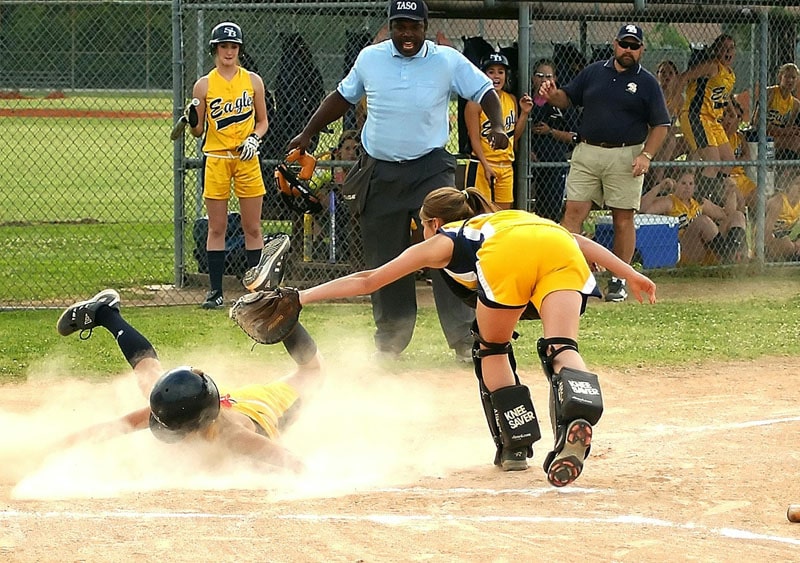Softball is a popular team sport. It is like baseball but has unique features that make it different. Softball began in the late 19th century. It was an indoor version of baseball but quickly became popular as an outdoor game. It is played on a smaller field with a larger, softer ball than baseball. This makes it accessible to players of all ages and skill levels. In this article, we will cover all the softball rules.
There are two main types of softball: slow-pitch and fast-pitch. In slow-pitch softball, the ball is pitched in a high arc, making it easier to hit. In a fast pitch, the ball is thrown with greater speed and precision. Each variant has its own rules and play style. They offer players diverse experiences.
Field and Equipment
A typical softball field is diamond-shaped. It’s like a baseball field, but smaller. The infield consists of four bases arranged in a square: first base, second base, third base, and home plate. The bases are usually 60 feet apart. But, it can vary by the type of softball being played. The pitching distance is 43 feet for fast-pitch and 50 feet for slow-pitch.
Equipment used in softball includes:
- Softball: A larger ball than a baseball, with a circumference of about 12 inches for both fast-pitch and slow-pitch.
- Bat: Made of metal or composite materials, lighter than a baseball bat. and designed for better control and power.
- Glove: Players use a glove to catch the ball. Outfielders use a larger glove for added reach.
- Protective Gear: Catchers wear helmets, face masks, chest protectors, and shin guards. Batters and base runners wear helmets to prevent injuries.

Basic Gameplay
- Objective: Score more runs than the other team. Players must round all the bases and reach home plate to score a run.
- Innings: The game consists of seven innings, each divided into two halves (Top half: The visiting team bats. & Bottom half: The home team bats.)
- Outs: Each team bats until three batters are out per half-inning.
- Team Structure: Each team fields nine players at a time.
- Winning: The team with the most runs after seven innings wins. If the game is tied, extra innings are played until a winner is determined.
Softball Pitching Rules
Pitching is critical to the game. The softball rules differ between slow-pitch and fast-pitch softball.
Slow-Pitch Softball:
- The ball is delivered in an underhand motion with an arc.
- The pitch must rise at least 6 feet and no more than 12 feet above the ground.
- No windmill or fast motion is allowed; the focus is on accurate, controlled pitches.

Fast-Pitch Softball:
- The ball is pitched with a fast, windmill-style underhand motion.
- Speed and accuracy are key, with pitches often exceeding 60 mph.
- The pitcher can vary pitch types (e.g., fastball, curveball) to challenge the batter.
Softball Batting Rules
Batting is one of the most exciting parts of softball. Key rules include:
- Each batter is allowed three strikes before being called out.
- A strike is a pitch within the strike zone that the batter either swings at and misses or does not swing at.
- A batter is awarded a walk if four balls are thrown outside the strike zone without a swing.
- A fair ball is one that is hit within the field of play, allowing the batter to attempt to reach base.
- A foul ball is hit outside the field of play or out of bounds. If a batter hits two foul balls, they are not penalized with a strike unless it’s the third strike.
- A walk occurs when the batter is pitched four balls outside the strike zone.
- A strikeout happens when the batter accumulates three strikes.
- In fast-pitch softball, players can bunt. This means lightly tapping the ball to put it in play.
Softball Base Running Rules
Base running is crucial for advancing players and scoring runs. Essential softball rules for running bases include:
- After hitting the ball, batters must run to first base. They can advance to additional bases if the ball is in play and no defensive player tags them out.
- If a runner must advance to the next base due to a runner behind them, the defense just needs to touch the base before the runner arrives to get an out.
- Runners must remain on their base until a caught fly ball is secured by the fielder. After the catch, they can try to advance to the next base. But, they must “tag up” by touching their starting base before advancing.
- In fast-pitch softball, runners can attempt to steal a base after the pitch is delivered. However, they cannot leave the base until the pitcher releases the ball.
- In most leagues, base runners are not allowed to leave the base until the ball is pitched. Leaving early can result in an out.
Softball Fielding Rules
Fielding is when the defense tries to stop the offense from scoring by getting outs. Key softball rules for fielding include:
- There are nine fielding positions: a pitcher, a catcher, four infielders, and three outfielders (left, center, and right).
- A force out occurs when a fielder touches a base with the ball before a runner reaches it. This applies when the runner is forced to advance by another base runner.
- If runners are not forced to advance, the fielder must tag the runner with the ball before they reach the base to get them out.
- A double play is when the defense gets two outs in one play. This often happens by getting a force out at one base, then throwing to another base to get a second runner out.
- If a fielder catches a fly ball (a ball hit in the air) before it touches the ground, the batter is out.

Special Softball Rules and Variations
Softball games can include special rules that vary by league or tournament. Common variations include:
- Mercy Rule: It ends the game early if one team is ahead by 10 or more runs after a certain number of innings. This rule prevents excessively lopsided games.
- Extra Innings: If the game is tied at the end of regulation innings, extra innings are played. Each team gets an additional chance to bat and field until one team has more runs at the end of an inning.
- Pitching Limits: Some leagues limit the number of pitches a pitcher can throw per game or per inning. This is to prevent overuse injuries.
Conclusion
Understanding softball rules is essential for enjoying the game, whether playing or watching. Each rule, from scoring and base running to pitching and fielding, contributes to the sport’s fast-paced, strategic nature. Special rules, such as the mercy rule and extra innings, add excitement and fairness to the game.
By grasping these softball rules, players can improve their skills. They will make better decisions on the field. And they will appreciate the dynamics of softball. Whether you’re a seasoned player or a newcomer, knowing these rules will enhance your experience. They will help you enjoy every inning to the fullest.







